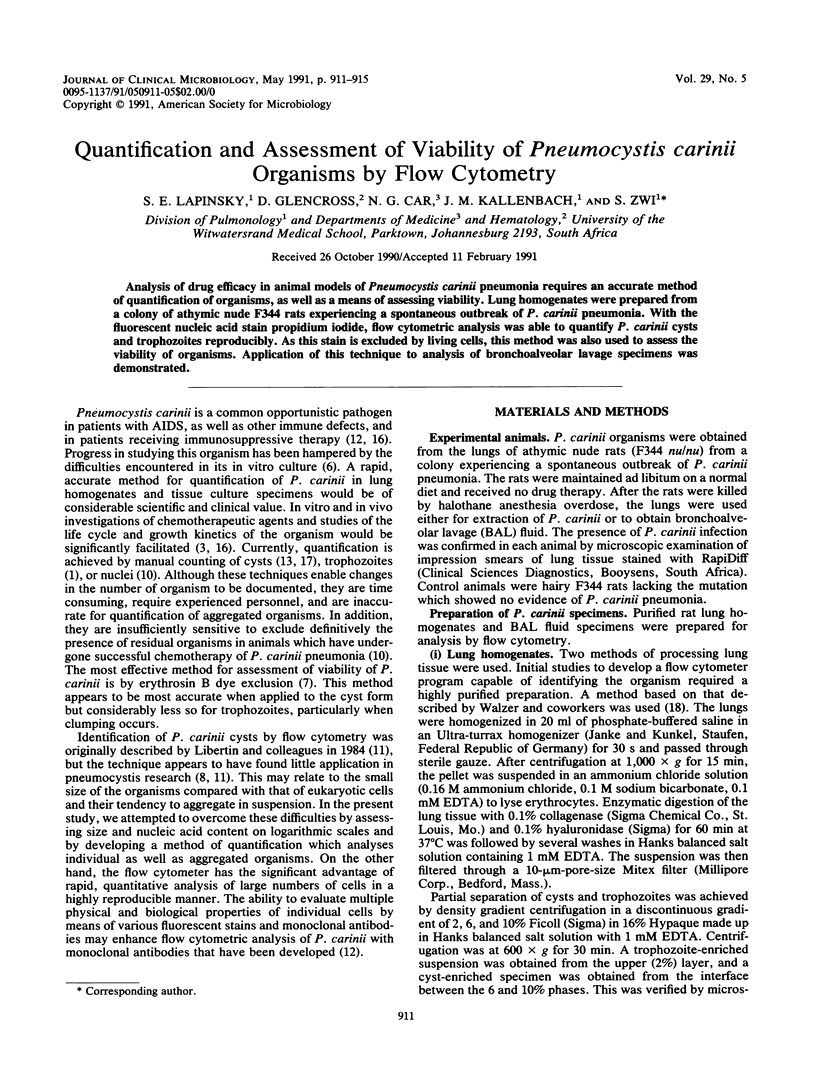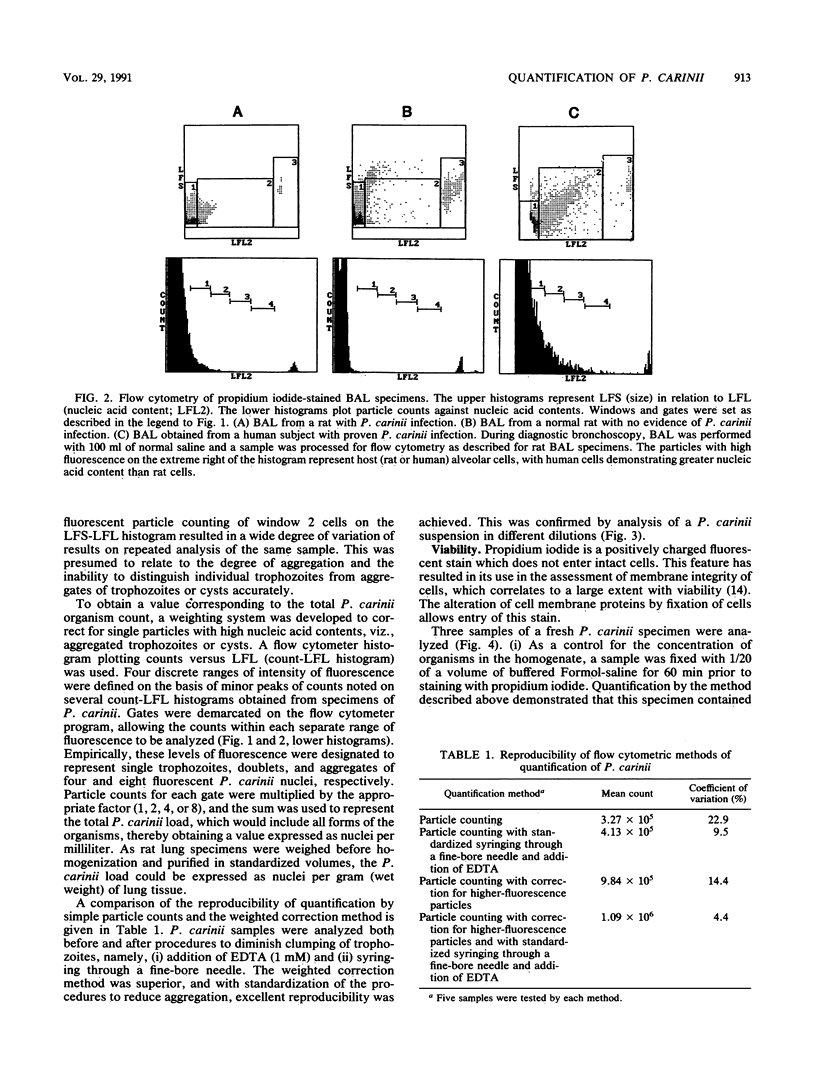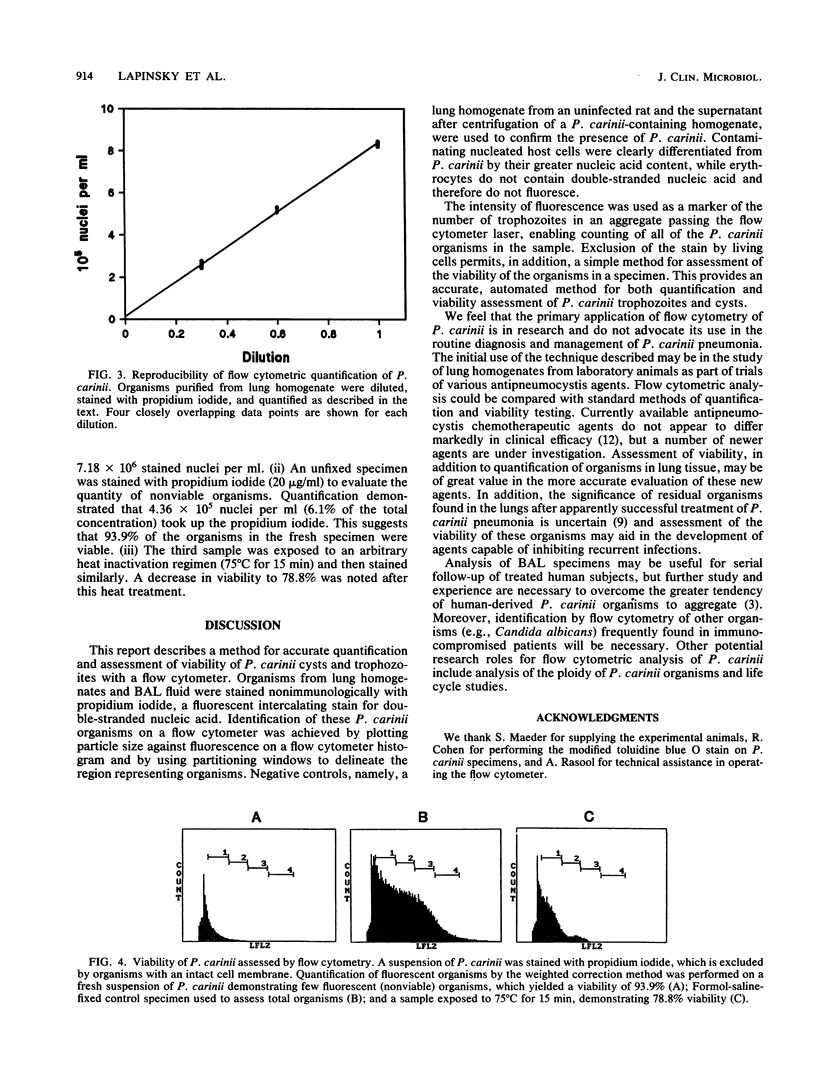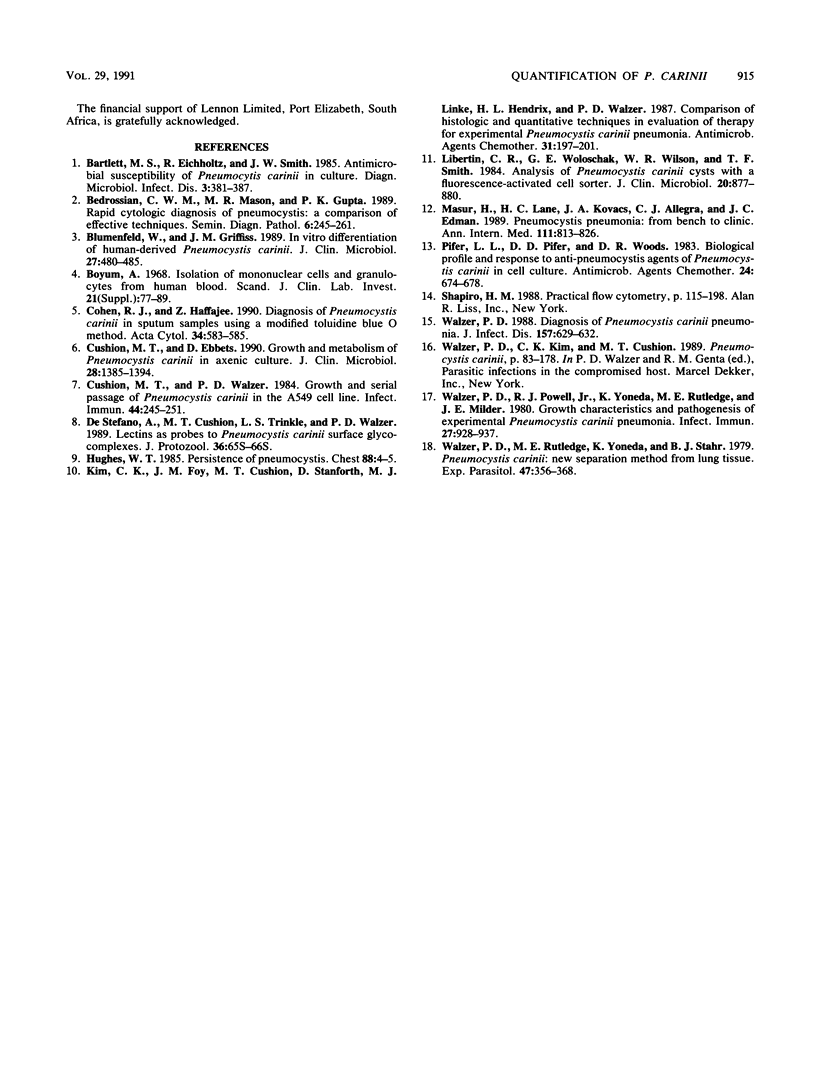Abstract
Analysis of drug efficacy in animal models of Pneumocystis carinii pneumonia requires an accurate method of quantification of organisms, as well as a means of assessing viability. Lung homogenates were prepared from a colony of athymic nude F344 rats experiencing a spontaneous outbreak of P. carinii pneumonia. With the fluorescent nucleic acid stain propidium iodide, flow cytometric analysis was able to quantify P. carinii cysts and trophozoites reproducibly. As this stain is excluded by living cells, this method was also used to assess the viability of organisms. Application of this technique to analysis of bronchoalveolar lavage specimens was demonstrated.
Full text
PDF




Selected References
These references are in PubMed. This may not be the complete list of references from this article.
- Bartlett M. S., Eichholtz R., Smith J. W. Antimicrobial susceptibility of Pneumocystis carinii in culture. Diagn Microbiol Infect Dis. 1985 Sep;3(5):381–387. doi: 10.1016/0732-8893(85)90076-8. [DOI] [PubMed] [Google Scholar]
- Bedrossian C. W., Mason M. R., Gupta P. K. Rapid cytologic diagnosis of Pneumocystis: a comparison of effective techniques. Semin Diagn Pathol. 1989 Aug;6(3):245–261. [PubMed] [Google Scholar]
- Blumenfeld W., Griffiss J. M. In vitro differentiation of human-derived Pneumocystis carinii. J Clin Microbiol. 1989 Mar;27(3):480–485. doi: 10.1128/jcm.27.3.480-485.1989. [DOI] [PMC free article] [PubMed] [Google Scholar]
- Böyum A. Isolation of mononuclear cells and granulocytes from human blood. Isolation of monuclear cells by one centrifugation, and of granulocytes by combining centrifugation and sedimentation at 1 g. Scand J Clin Lab Invest Suppl. 1968;97:77–89. [PubMed] [Google Scholar]
- Cohen R. J., Haffajee Z. Diagnosis of Pneumocystis carinii in sputum samples using a modified toluidine blue O method. Acta Cytol. 1990 Jul-Aug;34(4):583–585. [PubMed] [Google Scholar]
- Cushion M. T., Ebbets D. Growth and metabolism of Pneumocystis carinii in axenic culture. J Clin Microbiol. 1990 Jun;28(6):1385–1394. doi: 10.1128/jcm.28.6.1385-1394.1990. [DOI] [PMC free article] [PubMed] [Google Scholar]
- Cushion M. T., Walzer P. D. Growth and serial passage of Pneumocystis carinii in the A549 cell line. Infect Immun. 1984 May;44(2):245–251. doi: 10.1128/iai.44.2.245-251.1984. [DOI] [PMC free article] [PubMed] [Google Scholar]
- De Stefano J. A., Cushion M. T., Trinkle L. S., Walzer P. D. Lectins as probes to Pneumocystis carinii surface glycocomplexes. J Protozool. 1989 Jan-Feb;36(1):65S–66S. doi: 10.1111/j.1550-7408.1989.tb02704.x. [DOI] [PubMed] [Google Scholar]
- Hughes W. T. Persistence of pneumocystis. Chest. 1985 Jul;88(1):4–5. doi: 10.1378/chest.88.1.4. [DOI] [PubMed] [Google Scholar]
- Kim C. K., Foy J. M., Cushion M. T., Stanforth D., Linke M. J., Hendrix H. L., Walzer P. D. Comparison of histologic and quantitative techniques in evaluation of therapy for experimental Pneumocystis carinii pneumonia. Antimicrob Agents Chemother. 1987 Feb;31(2):197–201. doi: 10.1128/aac.31.2.197. [DOI] [PMC free article] [PubMed] [Google Scholar]
- Libertin C. R., Woloschak G. E., Wilson W. R., Smith T. F. Analysis of Pneumocystis carinii cysts with a fluorescence-activated cell sorter. J Clin Microbiol. 1984 Nov;20(5):877–880. doi: 10.1128/jcm.20.5.877-880.1984. [DOI] [PMC free article] [PubMed] [Google Scholar]
- Masur H., Lane H. C., Kovacs J. A., Allegra C. J., Edman J. C. NIH conference. Pneumocystis pneumonia: from bench to clinic. Ann Intern Med. 1989 Nov 15;111(10):813–826. doi: 10.7326/0003-4819-111-10-813. [DOI] [PubMed] [Google Scholar]
- Pifer L. L., Pifer D. D., Woods D. R. Biological profile and response to anti-pneumocystis agents of Pneumocystis carinii in cell culture. Antimicrob Agents Chemother. 1983 Nov;24(5):674–678. doi: 10.1128/aac.24.5.674. [DOI] [PMC free article] [PubMed] [Google Scholar]
- Walzer P. D. Diagnosis of Pneumocystis carinii pneumonia. J Infect Dis. 1988 Apr;157(4):629–632. doi: 10.1093/infdis/157.4.629. [DOI] [PubMed] [Google Scholar]
- Walzer P. D., Powell R. D., Jr, Yoneda K., Rutledge M. E., Milder J. E. Growth characteristics and pathogenesis of experimental Pneumocystis carinii pneumonia. Infect Immun. 1980 Mar;27(3):928–937. doi: 10.1128/iai.27.3.928-937.1980. [DOI] [PMC free article] [PubMed] [Google Scholar]
- Walzer P. D., Rutledge M. E., Yoneda K., Stahr B. J. Pneumocystis carinii: new separation method from lung tissue. Exp Parasitol. 1979 Jun;47(3):356–368. doi: 10.1016/0014-4894(79)90088-2. [DOI] [PubMed] [Google Scholar]


